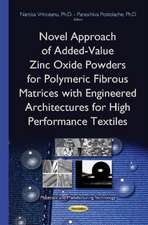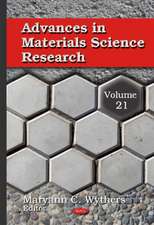Mechanics of Fibrous Composites
Autor M.H. Datooen Limba Engleză Hardback – 30 noi 1991
Preț: 1240.16 lei
Preț vechi: 1512.39 lei
-18% Nou
Puncte Express: 1860
Preț estimativ în valută:
237.34€ • 246.87$ • 195.93£
237.34€ • 246.87$ • 195.93£
Carte tipărită la comandă
Livrare economică 12-26 aprilie
Preluare comenzi: 021 569.72.76
Specificații
ISBN-13: 9781851666003
ISBN-10: 1851666001
Pagini: 636
Ilustrații: XIII, 636 p.
Dimensiuni: 155 x 235 x 35 mm
Greutate: 1.09 kg
Ediția:1991
Editura: SPRINGER NETHERLANDS
Colecția Springer
Locul publicării:Dordrecht, Netherlands
ISBN-10: 1851666001
Pagini: 636
Ilustrații: XIII, 636 p.
Dimensiuni: 155 x 235 x 35 mm
Greutate: 1.09 kg
Ediția:1991
Editura: SPRINGER NETHERLANDS
Colecția Springer
Locul publicării:Dordrecht, Netherlands
Public țintă
ResearchCuprins
1 Introduction.- 1.1 Fibrous Composites.- 1.2 FRP Constituents.- 1.3 Reinforcement Types.- 1.4 Types of Materials.- 1.5 Terminology.- 2 Ply Stiffness Analysis.- 2.1 Isotropic Ply.- 2.2 Specially Orthotropic Ply.- 2.3 Generally Orthotropic Ply.- 2.4 Transformation of Elastic Constants.- 2.5 Typical Elastic Properties.- 3 Ply Strength Analysis.- 3.1 Isotropic Ply.- 3.2 Orthotropic Ply.- 3.3 Failure Criteria.- 3.4 Sign of Shear Stresses.- 3.5 Choice of Failure Criterion.- 3.6 Typical Strength Properties.- 4 Layered Laminate.- 4.1 Beam Constitutive Equation.- 4.2 Laminate Constitutive Equation.- 4.3 Laminate Notation.- 4.4 Equivalent Elastic Constants.- 5 Laminate Stiffness Analysis.- 5.1 Stiffness Formulation Procedure.- 5.2 Laminate Configuration Types.- 5.3 Symmetric SOPL: Isotropic Plies.- 5.4 Symmetric SOPL: Specially Orthotropic Plies.- 5.5 Symmetric SOPL: Generally Orthotropic Plies.- 5.6 Symmetric MOPL: Isotropic Plies.- 5.7 Symmetric MOPL: Generally Orthotropic Plies.- 5.8 Symmetric MOPL: Cross-ply.- 5.9 Symmetric MOPL: Angle-ply.- 5.10 Symmetric MOPL: Quasi-isotropic.- 5.11 Antisymmetric MOPL: Cross-ply.- 5.12 Antisymmetric MOPL: Angle-ply.- 5.13 Estimated Membrane Elastic Constants.- 5.14 Laminate Stiffness: Summary.- 6 Laminate Strength Analysis.- 6.1 First-Ply-Failure (FPF) Procedure.- 6.2 FPF: Symmetric Laminate—Membrane Load.- 6.3 FPF: Symmetric Laminate—Bending Load.- 6.4 FPF: Unsymmetric Laminate—Membrane Load.- 6.5 Last-Ply-Failure (LPF) Procedure.- 6.6 LPF: Complete Ply Failure—Membrane Load.- 6.7 LPF: Partial Ply Failure—Membrane Load.- 6.8 LPF: Complete Ply Failure—Bending Load.- 6.9 Estimated Laminate Strength.- 6.10 Laminate Strength: Summary.- 7 Residual Stresses.- 7.1 Compound Isotropic Beam.- 7.2 Laminate Thermal Stresses.- 7.3Determining Thermal Residual Stresses.- 7.4 Constant Temperature Distribution.- 7.5 Hygroscopic Diffusion Mechanism.- 7.6 Laminate Hygroscopic Stresses.- 7.7 Constant and Linear Moisture Distribution.- 7.8 Influence on Laminate Strength.- 7.9 Typical Physical Properties.- 8 Thin-Walled Composite Sections.- 8.1 Assumptions and Axes Systems.- 8.2 Axial Force.- 8.3 Symmetrical Bending.- 8.4 Unsymmetrical Bending.- 8.5 Shear Forces.- 8.6 Torsion of Open Sections.- 8.7 Torsion of Closed Sections.- 9 Interlaminar Stresses.- 9.1 Free Edge Effects.- 9.2 Interlaminar Stress: fxz.- 9.3 Interlaminar Stresses: fyz and fz.- 9.4 Prediction Methods.- 9.5 Effect of Different Stacking Sequences.- 10 Miscellaneous Topics.- 10.1 Holes in Laminates.- 10.2 Buckling of Laminates.- 10.3 Computer Aided Laminate Analysis.- 10.4 FE Method: Line Elements.- 10.5 FE Method: Shell Elements.- 10.6 Test Methods.












